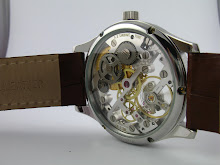
Today I decided to try a 1.3mm head. Since I turn between centres (on the turns), the first thing to do was to form a new cone on the end of the broken piece. The three pictures below show how this is done.



Once you have cones on both ends of the job, you can turn between two female centres. Below you can see that the shaft of the dial marker has been turned.

After this I prefer to start the parting cut & only then reduce the head to the correct size. The under side of the head needs special attention. I make it slightly concave to ensure that the marker sits on the dial true & flat.

After everything is done the dial marker blank is cut off with a saw.

This marker blank will be finalised after the dial is ready. Please note that it is still soft.


